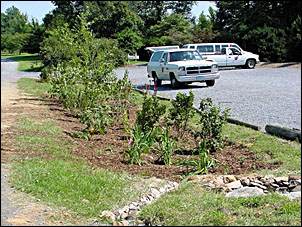Right as Rain
Although it comes as a surprise to many homeowners, the suburban neighborhood is a leading source of water pollution. Residential streets and driveways are inundated with oils and metals from cars and trucks, while lawns and gardens release fertilizers, herbicides and pesticides and pets deposit waste along curbsides. According to the Environmental Protection Agency, stormwater runoff from urban areas is the leading pollutant of rivers and lakes.
Homeowners can prevent pollutants from harming surface and groundwater by installing a rain garden, a pond-like recess shaped like a saucer or shallow bowl. Rainwater from the driveway, walkway and lawn is directed to flow into this depression, allowing the natural biochemical activity in mulch and soil to transform toxins into harmless compounds.

Following a storm, up to six inches of water settles in the garden basin, with the highest concentrations of pollutants in the first half-inch or first flush. Excess stormwater then flows into traditional stormwater outfalls or ditches. Water recedes in a couple of days through evapotransporation and infiltration. The trees, shrubs and perennials that landscape the rain garden absorb water and allow it to percolate through the soil, replenishing the groundwater table.
A rain garden contains three planting zones. The lowest will have periods of standing water and extended soil saturation. Plants for the lowest zone are selected for their tolerance to wet conditions. The middle zone will have periodic soil saturation, and the upper edge will be dry. Plants in the lower and middle zones must also tolerate fluctuating moisture. Plants in all zones will be subject to drought spells as well. A diversity of trees and shrubs native to local wetlands and streambanks are most suitable for the lower and middle zones. The upper rim of the garden can be planted in perennials.
Ten years ago, Larry Coffman, director of Maryland’s Prince George’s County Department of Environmental Resources, set out to address the detrimental impacts to streams that occur from converting forested land to impervious roadways, parking lots and rooftops. A rain garden was established along with other low-impact development techniques to reduce stormwater runoff. “Rain gardens combine environmentally sensitive site design with pollution prevention to form a comprehensive approach to water quality problems,” says Coffman.
Water Catchers
TABCO, the developer of Somerset, a residential subdivision in Prince George’s County, was a pioneer in using the rain garden for stormwater management. Each residential lot features a carefully landscaped 300- to 400-square-foot rain garden at a low point. “TABCO was committed to the concept as a more environmentally sensitive—and less expensive—way to develop the site,” says Coffman.
Joseph Murray, director of the arboretum at Blue Ridge Community College in Virginia, worked with the Virginia Department of Forestry to install a rain garden that would manage storm runoff, as well as serve as a demonstration project. Building the rain garden with the aid of student volunteers and materials donated by local businesses took only a few hours. “We had serious flooding problems in one part of our arboretum,” says Murray, “but that ended when the rain garden was installed a year and a half ago.”
According to Murray, the rain garden takes up five percent of the watershed area, and it was placed where the runoff naturally flowed to a downhill stream. Peat moss was added during planting to increase the ability of the soil to hold water. Volunteers surrounded the newly created basin with native plants, giving special consideration to those with a proven ability to resist heavy metals and salts. These included such hardy species as red chokeberry, buttonbush, spicebush and red twig dogwood. “After a rain, the rain garden is going to catch a large amount of water, and these plants will need to feel at home,” says Murray.
Make One Yourself
As a homeowner, you can retrofit a rain garden into the existing landscape simply by capturing runoff from parking areas, driveways, walkways, decks or roofs. Downspouts can be directed to discharge into a rain garden. A section of curb may be cut, allowing water to flow into a rain garden instead of out into the roadway. Incorporating berry- and nectar-producing plants into the design creates a wildlife garden that is beneficial to songbirds and butterflies.
Rain gardens are, unfortunately, not maintenance-free. During dry periods they need watering several times a week. Small berms (not higher than an inch) around each plant will help them hold water. Higher berms run the risk of attracting breeding mosquitoes. Mulching is also a good idea. Murray notes that rain gardens attract “bumper crops’ of weeds, so expect to spend some time on your hands and knees.
Rain gardens make the most sense for homeowners with property that slopes to a pond or stream, but even flatlanders will benefit from tree plantings or mulched garden areas that will hold stormwater runoff and prevent water pollution.

